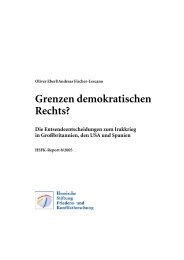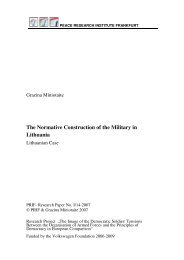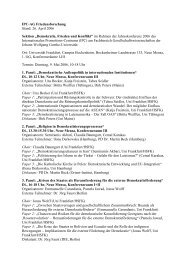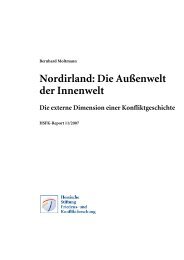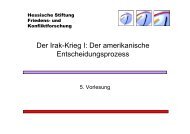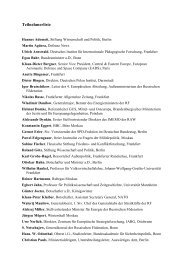From Exodus to Exitus Causes of post-war violence in El ... - eDoc
From Exodus to Exitus Causes of post-war violence in El ... - eDoc
From Exodus to Exitus Causes of post-war violence in El ... - eDoc
You also want an ePaper? Increase the reach of your titles
YUMPU automatically turns print PDFs into web optimized ePapers that Google loves.
8 Heidrun Z<strong>in</strong>ecker<br />
which generally amounts <strong>to</strong> murder. Police agents would be detected at this po<strong>in</strong>t, if not<br />
earlier. Women are no longer admitted <strong>in</strong><strong>to</strong> this mara. Gang members are now forbidden<br />
from tak<strong>in</strong>g drugs, with the exception <strong>of</strong> marijuana. Theft not sanctioned by the leader is<br />
punished. The general meet<strong>in</strong>gs <strong>of</strong> the clicas, the mir<strong>in</strong>s (now known as misas), are now<br />
held only by telephone. The casas “destroyer”, or safe houses used by mareros for meet<strong>in</strong>gs<br />
and sometime also <strong>to</strong> live <strong>in</strong>, have been abandoned. Nowadays, it is ma<strong>in</strong>ly penal <strong>in</strong>stitutions<br />
that are used specifically <strong>to</strong> provide structure and potential recruits <strong>to</strong> the maras.<br />
Violence has an even greater role <strong>to</strong> play for the maras than it did before, and is exercised<br />
<strong>in</strong>creas<strong>in</strong>gly forcefully on the civilian population as well. All these changes have made the<br />
maras more discipl<strong>in</strong>ed and flexible <strong>in</strong> the face <strong>of</strong> government strategy.<br />
Other than might generally be expected, mareros do not come either from the poorest<br />
strata <strong>of</strong> society or the most marg<strong>in</strong>alized parts <strong>of</strong> <strong>to</strong>wn, <strong>in</strong>stead they come from work<strong>in</strong>g<br />
class or lower middle class backgrounds, i.e. from sections <strong>of</strong> the population classified as<br />
the second and third <strong>in</strong>come qu<strong>in</strong>tiles (from the bot<strong>to</strong>m). They are not street children;<br />
they generally have a home, located <strong>in</strong> urban barrios with a high population density and<br />
most commonly <strong>in</strong> a rented house with a large number <strong>of</strong> <strong>in</strong>habitants. Mareros are also<br />
not <strong>war</strong> orphans. They do not come from asocial families. Their parents have an <strong>in</strong>come,<br />
and are <strong>of</strong>ten be<strong>in</strong>g sent remittances from family members work<strong>in</strong>g abroad. Mareros are<br />
educated <strong>to</strong> a higher level than the average Salvadoran. Mareros either left school early, or<br />
were unemployed or work<strong>in</strong>g <strong>in</strong> <strong>in</strong>secure part-time jobs before they jo<strong>in</strong>ed the maras (Carranza<br />
2006). 75 % <strong>of</strong> mareros are unemployed. When asked what they would most like <strong>to</strong><br />
have, the majority <strong>of</strong> mareros questioned replied: work (Homies Unidos 1998: 39, 113).<br />
3. Model<br />
The follow<strong>in</strong>g causal analysis <strong>of</strong> Salvadoran <strong>post</strong>-<strong>war</strong> <strong>violence</strong> – and also, although not exclusively,<br />
<strong>of</strong> the maras – adopts an aetiological sociostructural (macro-)approach as used <strong>in</strong><br />
crim<strong>in</strong>ology. This approach is based on the hypothesis that there are “conspicuous” societal<br />
structures which, <strong>in</strong> certa<strong>in</strong> life situations, exert a social pressure lead<strong>in</strong>g <strong>to</strong> deviant behaviour<br />
(Albrecht 2002: 31–33, 37–39). In the context <strong>of</strong> this theory I have elsewhere differentiated<br />
between enabl<strong>in</strong>g and preventive structures (Z<strong>in</strong>ecker 2006 a: 20-39). Enabl<strong>in</strong>g structures<br />
<strong>of</strong>fer fertile ground for (violent) crime. Preventive structures can act <strong>to</strong> ensure that<br />
there are no outbreaks <strong>of</strong> (violent) crime even where enabl<strong>in</strong>g structures are present.<br />
Where preventive structures are absent or poorly function<strong>in</strong>g, this makes the effects <strong>of</strong> the<br />
enabl<strong>in</strong>g structures stronger. I make the claim here that, <strong>in</strong> cases <strong>of</strong> <strong>in</strong>tensive <strong>violence</strong>, well<br />
developed enabl<strong>in</strong>g structures are work<strong>in</strong>g hand <strong>in</strong> hand with poorly function<strong>in</strong>g preventive<br />
structures.<br />
Enabl<strong>in</strong>g structures can be political and economic <strong>in</strong> nature. A political enabl<strong>in</strong>g structure<br />
which particularly benefits <strong>violence</strong> (and not only <strong>war</strong>) is semi-democracy, which I<br />
describe as regime hybridity, because this term is more precise and gives a better <strong>in</strong>dication<br />
that the regimes <strong>in</strong> question, while not authoritarian, are also simply not democratic.





